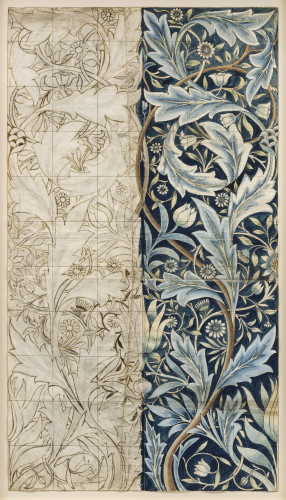A design for a tile panel composed of 66 earthenware tiles with painted underglaze decorated with a ‘drop’ design of foliage of Persian inspiration, in green and blue on a blue ground. This tile panel was designed by William Morris and produced by William De Morgan in 1876 and is one of six; one of which is WMG C176. They were commissioned by the banker, Edward Baring, for his bathroom at Membland Hall, north of Plymouth (now demolished).
William De Morgan had set up his pottery in Chelsea in 1872 and had already designed tile panels, and as many as 300 six inch tiles by 1877. The Membland Hall commission was to be the largest panel he had attempted. Each panel measures 1600mm x 915mm, and is made up of 66 six inch tiles. It was a remarkable achievement to have produced these large panels on such small premises.
The design for these panels is composed differently to Morris’s wallpaper designs of that period, having larger motifs and more free space. The wallpapers had smaller detail and denser patterning. The repeat design at the edges indicates that the panels were intended to be set close together so that the pattern could progress laterally.
The design for these tile panels appeared in the Morris firm’s stock-list as late as 1913. It is unlikely that Morris designed anything as large again.
Membland Hall was demolished in 1928 for its lead and fireplaces. The six panels appeared on the London market in 1972. They had been found in a cupboard at Membland Hall. Another tile of the six is on display at the V&A, London. A tile of this design is in the collection of the Museum of Applied Arts, Cologne (E04941) and was acquired in 1978.
